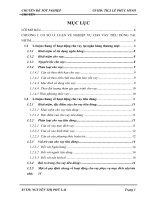02-Expressions
Bạn đang xem bản rút gọn của tài liệu. Xem và tải ngay bản đầy đủ của tài liệu tại đây (246.07 KB, 32 trang )
Variables, Expressions, and
Statements
Chapter 2
Constants
•
Fixed values such as numbers, letters, and strings are called
“constants” - because their value does not change
•
Numeric constants are as you expect
•
String constants use single-quotes (')
or double-quotes (")
>>> print 123
123
>>> print 98.6
98.6
>>> print 'Hello world'
Hello world
Variables
•
A variable is a named place in the memory where a programmer can
store data and later retrieve the data using the variable “name”
•
Programmers get to choose the names of the variables
•
You can change the contents of a variable in a later statement
12.2
x
14
y
x = 12.2
y = 14
100
x = 100
Python Variable Name Rules
•
Must start with a letter or underscore _
•
Must consist of letters and numbers and underscores
•
Case Sensitive
•
Good: spam eggs spam23 _speed
•
Bad: 23spam #sign var.12
•
Different: spam Spam SPAM
Reserved Words
•
Yo u can not use reserved words as variable names / identifiers
and del for is raise
assert elif from lambda return
break else global not try
class except if or while
continue exec import pass yield
def finally in print
Sentences or Lines
x = 2
x = x + 2
print x
Variable Operator
Constant Reserved Word
Assignment Statement
Assignment with expression
Print statement
Assignment Statements
•
We assign a value to a variable using the assignment statement (=)
•
An assignment statement consists of an expression on the right hand
side and a variable to store the result
x = 3.9 * x * ( 1 - x )
x = 3.9 * x * ( 1 - x )
0.6
x
Left side is an expression. Once
expression is evaluated, the result
is placed in (assigned to) x.
0.6
0.6
0.4
0.93
A variable is a memory location
used to store a value (0.6).
x = 3.9 * x * ( 1 - x )
0.6 0.93
x
Right side is an expression. Once
expression is evaluated, the result
is placed in (assigned to) the
variable on the left side (i.e. x).
0.93
A variable is a memory location
used to store a value. The value
stored in a variable can be updated
by replacing the old value (0.6)
with a new value (0.93).
Numeric Expressions
•
Because of the lack of mathematical
symbols on computer keyboards - we
use “computer-speak” to express the
classic math operations
•
Asterisk is multiplication
•
Exponentiation (raise to a power) looks
different from in math.
Operator Operation
+ Addition
- Subtraction
* Multiplication
/ Division
** Power
% Remainder
Numeric Expressions
>>> xx = 2
>>> xx = xx + 2
>>> print xx
4
>>> yy = 440 * 12
>>> print yy
5280
>>> zz = yy / 1000
>>> print zz
5
>>> jj = 23
>>> kk = jj % 5
>>> print kk
3
>>> print 4 ** 3
64
Operator Operation
+ Addition
- Subtraction
* Multiplication
/ Division
** Power
% Remainder
5 23
4 R 3
20
3
Order of Evaluation
•
When we string operators together - Python must know which one
to do first
•
This is called “operator precedence”
•
Which operator “takes precedence” over the others
x = 1 + 2 * 3 - 4 / 5 ** 6









